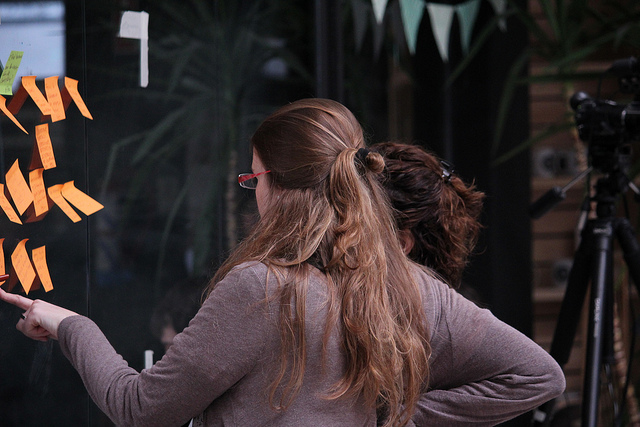Unlock the Magic in Your Story Now
Get the Free 20 questions to Ask Before Launching Your Idea workbook when you sign up for occasional updates.
Get the Free 20 questions to Ask Before Launching Your Idea workbook when you sign up for occasional updates.
The Art Of Differentiation
filed in Storytelling, Success
 We, humans, have always been good at noticing what’s compelling about others. Our species’ survival has depended on our ability to recognise strengths and weed out weaknesses. Today, that skill leads us down the road of unhealthy comparison. We have no trouble rattling off the positive attributes of a colleague, competitor or even the guy working out next to us at the gym. And yet we struggle to be as generous about our own.
We, humans, have always been good at noticing what’s compelling about others. Our species’ survival has depended on our ability to recognise strengths and weed out weaknesses. Today, that skill leads us down the road of unhealthy comparison. We have no trouble rattling off the positive attributes of a colleague, competitor or even the guy working out next to us at the gym. And yet we struggle to be as generous about our own.
It’s fine for Roger Federer to study a competitor’s gameplay before they go head-to-head because he needs to respond tactically in the moment. But the majority of Federer’s winning shots come from understanding his strengths and working on what he does well. Becoming more of who he is gets him over the line.
It’s doubtful that comparing yourself or your work to someones else’s will get you to where you want to go. Whether as an individual or a brand—you can’t own your unique identity if you’re spending the majority of your time looking over your shoulder. Differentiation happens when you authentically amplify the best of you. Not by finding ways to be a version of the competition, but by discovering how to be more of who you are. That’s where your search for clarity needs to begin.
Image by Marianne Bevis
Share this article
The Power Of Constraints
filed in Marketing, Storytelling
 What’s the best thing about the place where you live?
What’s the best thing about the place where you live?
What word describes your favourite book?
What’s the first thing you tell a friend when you recommend a special restaurant?
What standout experience made your last holiday memorable?
What’s the main reason you shop where you do?
What’s the biggest benefit of flying with this airline and not that one?
Why choose Apple over Android? Coffee instead of tea? Vanilla above chocolate?
If you could tell a prospective customer just one thing about your product or service—what would that one thing be? Constraints can be a powerful way to get to the heart or what’s important to both you and the people you hope to serve.
Image by Edwin Bachetti
Share this article
What The Best Marketers Know
filed in Marketing
 The call centre operator insists ‘this is not a cold call’. She knows time is running out, so she desperately accelerates her sales pitch—speaking without pausing to either breathe or listen. She was trained to believe it’s possible to close the sale if she can just impart all the information in her script. Sadly, she’s been misled.
The call centre operator insists ‘this is not a cold call’. She knows time is running out, so she desperately accelerates her sales pitch—speaking without pausing to either breathe or listen. She was trained to believe it’s possible to close the sale if she can just impart all the information in her script. Sadly, she’s been misled.
The best marketers know permission is a requirement, not an option.
That people rarely make decisions based on the facts
And stories create value.
The best marketers know patience trumps pressure and trust takes time.
That generosity and empathy are underrated.
And there is no shortcut to mattering.
The best marketers know every day starts with a choice.
That we can choose to be the best or take the shortcut.
Which will you choose today?
Image by World Bank
Share this article
Flipping The Focus Group
filed in Brand Naming, Marketing
 We’ve been using focus groups for eighty years in an attempt to understand how to create things people want to buy and messages they want to hear. And while we question what our customers like and what demographic they fit into, we rarely think about who they are beyond the choices they make. What if we flipped our usual pattern of trying to understand to be understood on its head?
We’ve been using focus groups for eighty years in an attempt to understand how to create things people want to buy and messages they want to hear. And while we question what our customers like and what demographic they fit into, we rarely think about who they are beyond the choices they make. What if we flipped our usual pattern of trying to understand to be understood on its head?
Seven Customer-Focused Questions
1. What’s the first thing that comes to mind when you think about your customer?
2. What three words would you use to describe him?
3. What do you like best about him?
4. What are his strengths and weaknesses?
5. How does working with or creating for him make you feel?
6. If you could change one thing about him what would that be?
7. What else can you say about him?
When we change how we think about our customers everything we do changes too.
Image by Carol P
Share this article
A World Built On Promises
filed in Storytelling, Strategy
 Today you woke in a bed the manufacturer promised would give you a good nights sleep. You ate something for breakfast that was made in a factory you have never visited or grown by someone you have never met.
Today you woke in a bed the manufacturer promised would give you a good nights sleep. You ate something for breakfast that was made in a factory you have never visited or grown by someone you have never met.
You belted yourself into a car with a safety rating you have no way of verifying and drove to work on roads you didn’t inspect for potholes. You left your kids with teachers whose qualifications you have never seen.
You assumed the coffee the barista served you was decaffeinated, though you have no way of checking. And you drank tap water that you’ve never tested with your lunch.
You knew the free-range chicken you cooked for dinner was in date because the packaging said so. You didn’t question whether your broccoli really was organic because it came certified from a particular store.
You stacked and turned on the dishwasher knowing you would have clean spoons by morning. You set your alarm, certain it would wake you at the right time tomorrow as it always does.
We live in a world built on promises.
It only works when we each do our bit to make them and keep them.
Image by The 5th
Share this article
Exactly What To Do
filed in Strategy
 When faced with a challenge, we seek out a sure-fire solution. We want to know exactly what to do.
When faced with a challenge, we seek out a sure-fire solution. We want to know exactly what to do.
We long for the step-by-step guide. The right answer. A formula to follow and faithfully replicate. Formulas work. They give us the answer to questions that have been asked before. But it’s only by being willing to ask new questions and explore untested solutions that we arrive at original ideas.
What’s greater than the prospect of failure is the risk of standardising our way to mediocrity.
Certainty is overrated.
Share this article
Impression Vs. Intention
 The ladies changing room at the gym first thing in the morning can feel like a mean environment. It’s every woman for herself as we each carve out a floor tile’s worth of space to change. Spots in front of mirrors are gold. Hairdryers and straighteners as tightly held as premium real estate. The amount of time we spend fussing over our appearance seems longer these days. Let’s blame it on ‘the Instagram factor’. We now prime our faces before applying makeup and iron our hair after drying. We stare, unseeing at our reflections. We are all sharp elbows and hard edges.
The ladies changing room at the gym first thing in the morning can feel like a mean environment. It’s every woman for herself as we each carve out a floor tile’s worth of space to change. Spots in front of mirrors are gold. Hairdryers and straighteners as tightly held as premium real estate. The amount of time we spend fussing over our appearance seems longer these days. Let’s blame it on ‘the Instagram factor’. We now prime our faces before applying makeup and iron our hair after drying. We stare, unseeing at our reflections. We are all sharp elbows and hard edges.
Beautiful and ugly at once.
We work on our appearance to make an impression, forgetting that lasting impressions are more than skin deep. People don’t only judge us by our appearance. They get a sense of who we are from the way we move through the world. And so it goes at work and in business too.
There was a little tasting table at our local organic shop. Every day there was something different and delicious to try. On Saturdays and Sundays, the table created a party atmosphere. It was laid out as if to welcome guests with dips and vegetables, olives and gluten-free bread, dark chocolate and raw slices. Then one weekend, without warning things changed. Cutbacks. Since there was no measurable return on investment, the generosity would have to be scaled back. When the table changed the energy in the shop changed too. There was a little less joy and community. People became shoppers, more business-like, quieter, efficient. They didn’t linger.
We get to choose how we show up every day. We can be all sharp elbows, jockeying for position in front of the mirror or we can intentionally bring the kind of energy that changes everything into the room. Things like clean shopfronts, great design and beautiful packaging can attract customers, enhance credibility and build trust. But they’re not the reason people keep coming back.
Image by Alex Naanou
Share this article
How To Get Better At Pitching
filed in Marketing, Storytelling
 Every day we fail to convince people about the value we can deliver. For every yes, we get ten no’s. Why? We’re quick to blame the quality of our ideas or our storytelling when we fail. But sometimes we fail because we’re speaking to the wrong person at the wrong time. Rejections often happen because we haven’t qualified the buyer before trying to close the sale, so we need to get better at doing the groundwork.
Every day we fail to convince people about the value we can deliver. For every yes, we get ten no’s. Why? We’re quick to blame the quality of our ideas or our storytelling when we fail. But sometimes we fail because we’re speaking to the wrong person at the wrong time. Rejections often happen because we haven’t qualified the buyer before trying to close the sale, so we need to get better at doing the groundwork.
Five Questions To Answer Before Pitching
1. Am I pitching to the right person?
Often you’re pitching to someone who doesn’t have the authority to make the decision. Check.
2. What’s the underlying need (read fear) of the person I’m speaking to?
You must understand the client’s primary pain point before explaining how you can solve their problem. Question.
3. Is the prospective client ready to buy?
Sometimes the person wants to have a conversation about their challenge. They may not be in the market for a solution. Query.
4. Does your prospective customer’s budget align with your fee?
Make sure the numbers stack up before you have a conversation. Ask.
5. Why you (in particular)?
It’s important to know how the prospective client heard about you and why they felt compelled to contact you. A recommendation is different from a Google search. A reputation that precedes you trumps stumbling on your LinkedIn profile. Enquire.
We spend a lot of time telling our story to people who have no intention of buying. As my friend James Victore says, your work is a gift. Make sure you’re devoting your energy to the people who do want your help.
Image by Steven Zwerink
Share this article
A Thousand Times
 The young mother explains the dangers of running across the road to her toddler for what seems like the thousandth time. The Japanese furniture maker begins sanding the chair his customer in Sydney ordered six months ago. The app developer reads every review of his beta looking for ways to make it better. The barista pulls his thousandth shot of the week as it if were his first.
The young mother explains the dangers of running across the road to her toddler for what seems like the thousandth time. The Japanese furniture maker begins sanding the chair his customer in Sydney ordered six months ago. The app developer reads every review of his beta looking for ways to make it better. The barista pulls his thousandth shot of the week as it if were his first.
What do you care enough about to do it for the thousandth time?
This is my 1000th blog post. Thank you a thousand times for giving me a reason to write.
Image by Jonathan Grado
Share this article
Keeping Score

Kill rivals, don’t collaborate. That’s what “fire-in-the-belly visionaries” do. The recent article in the Financial Review was reporting remarks from a speaker at their innovation summit. In his opinion, Australian businesses are too friendly. If we are to survive, we need to behave more like Amazon and Uber—”hyper-competitive, Darwinian killing machines.”
A reminder of how far astray the way we keep score has led us. Yes, our species survived because we gained physical advantages over our predecessors. But we thrived because of our ability to cooperate within our tribe. We would never have become what we are today if we hadn’t built camps and begun living and collaborating in clans. We evolved as a species to both survive and belong. We succeed when we strive to become better and look out for each other—when we find purpose and meaning without always keeping score.
What kind of world do you want to wake up in tomorrow? Because that’s the world, you’ll create with the intention you set today. You can obsess over your competition or focus on creating the future you want to see.
Image by Zona